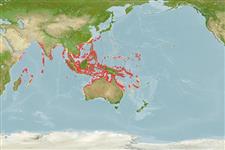Environment: milieu / climate zone / depth range / distribution range
Écologie
marin récifal; profondeur 3 - 30 m (Ref. 48637), usually 5 - 30 m (Ref. 27115). Tropical; 24°C - 27°C (Ref. 27115); 30°N - 30°S, 49°E - 170°E
Indo-West Pacific: Aldabra Islands, Seychelles, Maldives, Andaman Sea, Thailand, Indonesia, Peninsular Malaysia, Sabah, Singapore, Viet Nam, Philippines, Ryukyu Islands, Ogasawara Islands, Palau, ?Kiribati, Papua New Guinea, Solomon Islands, Australia, Vanuatu, and New Caledonia. Replaced by Siganus trispilos in northwest Australia (Ref. 37816).
Taille / Poids / Âge
Maturity: Lm ? range ? - ? cm
Max length : 35.0 cm SL mâle / non sexé; (Ref. 48637); common length : 20.0 cm TL mâle / non sexé; (Ref. 9813)
Épines dorsales (Total): 13; Rayons mous dorsaux (Total): 10; Épines anales 7; Rayons mous anaux: 9; Vertèbres: 13. Head, body and fins orange-yellow; pale blue ocelli with darker blue margins on head, thorax and sides; spots about pinhead size, larger and more crowded on head, sometimes smaller on sides; ocelli may extend onto bases of dorsal and anal fins, and on bases of outer rays of caudal fin. Very small juveniles (up to 50 mm SL) may have vertical blue lines on side, fragmenting into the ocelli with increase in size. Orbit with a diffused-edged dark, triangular smudge; orange-brown iris Fin spines stout, pungent and venomous. Midline of thorax and ridges fully scaled.
Occurs in coral-rich areas of lagoons. Juveniles found in small schools in shallow seagrass beds and reefs; often found among Acropora corals. Adults usually in pairs on shallow coral reefs and feed on benthic algae. A food fish that is occasionally poisonous (Ref. 4537, 48637).
Life cycle and mating behavior
Maturité | Reproduction | Frai | Œufs | Fécondité | Larves
Woodland, D.J., 1990. Revision of the fish family Siganidae with descriptions of two new species and comments on distribution and biology. Indo-Pac. Fish. (19):136 p. (Ref. 1419)
Statut dans la liste rouge de l'IUCN (Ref. 130435)
Utilisations par l'homme
Pêcheries: commercial; Aquarium: Commercial
Plus d'informations
Noms communsSynonymesMétabolismePrédateursÉcotoxicologieReproductionMaturitéFraiRassemblement de ponteFéconditéŒufsDéveloppement de l'œuf
RéférencesAquacultureProfil d'aquacultureSouchesGénétiqueElectrophoresesHéritabilitéPathologiesTraitementNutrientsMass conversion
Outils
Articles particuliers
Télécharger en XML
Sources Internet
Estimates based on models
Preferred temperature (Ref.
123201): 24.7 - 29, mean 28.1 °C (based on 1288 cells).
Phylogenetic diversity index (Ref.
82804): PD
50 = 0.5000 [Uniqueness, from 0.5 = low to 2.0 = high].
Bayesian length-weight: a=0.01072 (0.00601 - 0.01909), b=3.17 (3.02 - 3.32), in cm total length, based on LWR estimates for this species & Genus-body shape (Ref.
93245).
Niveau trophique (Ref.
69278): 2.0 ±0.0 se; based on diet studies.
Résilience (Ref.
120179): Haut, temps minimum de doublement de population inférieur à 15 mois (Preliminary K or Fecundity.).
Fishing Vulnerability (Ref.
59153): Low to moderate vulnerability (33 of 100).
Nutrients (Ref.
124155): Calcium = 34.9 [17.2, 80.0] mg/100g; Iron = 0.648 [0.306, 1.487] mg/100g; Protein = 18.5 [17.0, 20.0] %; Omega3 = 0.1 [0.1, 0.2] g/100g; Selenium = 21.7 [8.7, 54.3] μg/100g; VitaminA = 32.8 [7.7, 133.2] μg/100g; Zinc = 1.33 [0.52, 2.82] mg/100g (wet weight);
